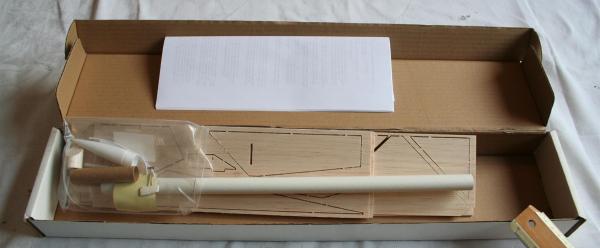| Construction Rating: | starstarstarstarstar_border |
| Flight Rating: | starstarstarstar_borderstar_border |
| Overall Rating: | starstarstarstarstar_border |
| Manufacturer: | Orbital Engineering Ltd |
Brief:
A friend of mine had the VMX-2, which was designed for B and C plugged motors. On a B its flights were near perfect.
It would hang in the air, and when it eventually came down it always slowly bellied down perfectly. Unfortunately the
VMX-2 flew off on a C6 after hanging in the air for what seemed like hours (but was probably 3 or 4 minutes), we lost
sight out it as it slowly climbed over 200 foot on a thermal. A year later I purchased the VMX-12. I think the number
refers to the prototype, so there could have been 9 other VMX designs between the two models. The VMX-12 is designed
for C or D plugged motors. The guys at Orbital engineering have spent a lot of time and test flights to produce a
reliable, sleek, duration space plane.
Construction:
The kit comes in cardboard box with a picture of the VMX in flight. The first thing you notice is the quality. The
balsa is high grade and the parts are machine cut. The tube has only shallow grooves, and the nose mass is cast lead
and fits the nosecone perfectly. The instructions are incredibly detailed, and have the website address so that you can
get tips from other builder of the space plane.


The plane is relatively easy to build provided that you have some building experience. It is a sleek design. As you put it together you start to see the design concepts, ranging from the double delta wing to the ever so slight dihedral. There is also no aerofoil on the wings, all the lift in the glide phase cones from the movement of the elevons.
The tricky part of construction comes from fitting the mylar hinges, 8 in total. This involves cutting 16 slits length ways and inserting mylar strips as hinges. Then the hinges are riveted in place with either CA glue or cocktail sticks; I used the CA glue option. The instructions suggest using a hinge cutter. I had already cut the eight slots in the main body of the plane, which had taken much longer than I had expected. I then found myself in my local hobby store and purchased a hinge cutter. If you can, buy one before you build this spaceplane. With the hinge cutter it takes seconds to cut a perfectly aligned hinge to the correct depth.
The rest of the instructions are straightforward and the plane assembles quickly and easily.
The final step is getting the tension on the elastic correct. To do this it is a matter of trial and error. I liked this elevon deployment system. Unlike other gliders, like Edmonds Ecee Thunder, Estes Tomcat, Fun Rockets Swinger, that all use the ejection charge on the motor to alter the rocket to its glide position. The VMX's elevons flip up as soon as the thrust drops and do not have to wait for a delay and ejection charge. Having watched my Tomcat fall from the sky, picking up speed, and then the 3 second delayed charge going off just before lawn darting, this system should perform better. The only down side is that if you over-tension the elastic, the spaceplane will loop backwards under full thrust.
Finishing:
The instructions do not recommend painting, and I did not. The Spaceplane looks good in its bare balsa. You can add
one thin coat of sealer to the space plane, but this needs to be sanded back to the balsa--it is only intended to fill
in any grooves. The main point is to add as little mass to the plane as possible.
Construction Rating: 4 out of 5
Flight and Recovery:
Before flight, the instructions recommend trimming. Normally I do a few throws and do a rough trim from that. This is
because most rocket gliders perform differently in the air to what happens on a quick throw. For the VMX, I went
searching for a steep-ish slope, and did several test throws with trimming when necessary.
The only recommended motor is a plugged D11, which is friction fit as there is no positive retention system.
She took off quick on a D11-P and about 40 foot off the pad one of the fins ripped off, she still flew straight until the motor burned out and then spiraled down to the ground. She landed in a cornfield and I never found her. Looking at the piece of fin that I did recover, the balsa failed and split.
Flight Rating: 3 out of 5
Summary:
I was unlucky with mine. I will probably buy the VMX-2 as a replacement.
Overall Rating: 4 out of 5
Sponsored Ads
 |
 |











